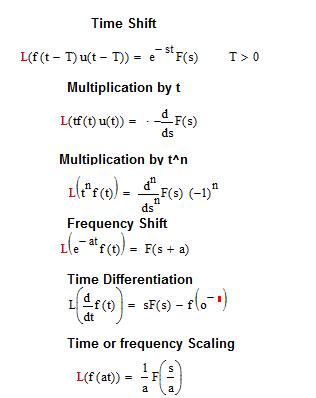Basic Laplace Transforms: Difference between revisions
Jump to navigation
Jump to search
(New page: [[Image:[[Image:'''Basic Laplace Transforms''' The laplace transform has the standard form of: :<math>F(s) = \mathcal{L} \left\{f(t)\right\}=\int_0^{\infty} e^{-st} f(t) \,dt </math> (C...) |
No edit summary |
||
| (4 intermediate revisions by one other user not shown) | |||
| Line 1: | Line 1: | ||
'''Basic Laplace Transforms''' |
|||
The laplace transform has the standard form of: |
The laplace transform has the standard form of: |
||
| Line 5: | Line 5: | ||
:<math>F(s) = \mathcal{L} \left\{f(t)\right\}=\int_0^{\infty} e^{-st} f(t) \,dt </math> (Cited From Fullerton, Colby) |
:<math>F(s) = \mathcal{L} \left\{f(t)\right\}=\int_0^{\infty} e^{-st} f(t) \,dt </math> (Cited From Fullerton, Colby) |
||
However, in this class applying the standard form exclusively to solve problems is not practical. The use of Laplace transform properties greatly simplifies problems. These properties are listed in the book on page 525. The simple properties are listed below and |
However, in this class applying the standard form exclusively to solve problems is not practical. The use of Laplace transform properties greatly simplifies problems. These properties are listed in the book on page 525. The simple properties are listed below and are imported images from mathcad. |
||
'''Linearity''' |
'''Linearity''' |
||
| Line 15: | Line 15: | ||
''' |
'''Example:''' |
||
If F(s)=(s+2)/(S+1) and f(t)=0 for t<0, then find the Laplace transform for the following functions identifying each property used to compute answers. |
|||
'''(a)''' <math>g_1(t)=5f(t-2)</math> '''(b)'''<math>g_2(t)=5(e^{-2t})f(t)</math> |
|||
(a) Linearity: |
|||
<math>F(s)=(5(s+2))/(s+1)</math> |
|||
Time Shift: |
|||
<math>\mathcal{L} \left\{f(t-2)u(t-2)\right\}=e^{-2s}F(s) </math> = '''<math>(5e^{-2s}(s+2))/(s+1)</math>''' |
|||
(b) Linearity: <math>a_1F(s) = {5(s+2)}/(s+1) </math> |
|||
Frequency Shift: |
|||
<math>\mathcal{L} \left\{e^{-at}f(t)\right\}=F(s+a) </math> |
|||
<math>(5((s+2)+2)))/((s+2)+1)=(5s+20)/(s+1)</math> |
|||
<u>'''Author:'''</u> |
|||
Jaymin Joseph |
|||
'''<u>Reviewed by:</u>''' |
|||
*[[Grant, Joshua|Joshua Grant]] |
|||
<u>'''Read By:'''</u> |
|||
Latest revision as of 12:40, 20 January 2010
Basic Laplace Transforms
The laplace transform has the standard form of:
- (Cited From Fullerton, Colby)
However, in this class applying the standard form exclusively to solve problems is not practical. The use of Laplace transform properties greatly simplifies problems. These properties are listed in the book on page 525. The simple properties are listed below and are imported images from mathcad.
Linearity
Example:
If F(s)=(s+2)/(S+1) and f(t)=0 for t<0, then find the Laplace transform for the following functions identifying each property used to compute answers.
(a) (b)
(a) Linearity:
Time Shift: =
(b) Linearity:
Frequency Shift:
Author:
Jaymin Joseph
Reviewed by:
Read By:









